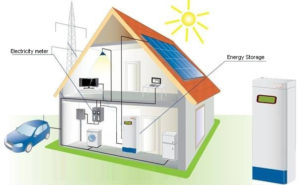Skip to content
Dive Brief:
Residential energy storage deployments hit a record in the first quarter, according to the latest U.S. Energy Storage Monitor report from GTM Research and the Energy Storage Association.
There was as much grid-connected residential storage deployed in the first quarter, 36 MWh, as was deployed in the previous three quarters, according to the report.
Much of the increase in residential energy storage deployments can be attributed to changing policies in California and Hawaii, which together accounted for 74% of the residential deployments in the quarter, according to the report.

Dive Insight:
Both California and Hawaii have made changes to their solar programs over the past few years that resulted in reduced net metering compensation, which consequently increases incentives for energy storage.
Hawaii, for example, capped its consumer grid supply program and placed an export moratorium on its consumer self-supply program. Both programs were put in place as alternatives to the state’s net metering program, which was canceled in 2015.
California is transitioning to time of use (TOU) rates, causing greater customer demand for storage because it will give them greater control over their electricity bills, a senior analyst on energy storage at GTM, Brett Simon, told Utility Dive via email.
The combination of California’s TOU rates and the state’s Self Generation Incentive Program (SGIP) makes solar-plus-storage almost competitive with solar-only, based on 2018 assumptions, Simon said, adding that solar-plus-storage will be the superior choice for homeowners on TOU rates within a few years.
Solar-plus-storage is, in fact, emerging as a key driver in the growth of the energy storage market. “More than 95% of all residential storage is solar-paired,” Simon said. It is also an important factor in the commercial and industrial and the front-of-the-meter markets (FTM), he said.
Residential storage systems accounted for 28% of the megawatt hours deployed in the first quarter, but the residential segment was second behind the FTM segment, which accounted for 51% of deployments. The non-residential segment, meanwhile, accounted for only 21% of the deployed MWh.
Overall, 126 MWh of energy storage were deployed in the first quarter, a 26% increase from fourth quarter 2017, but a 46% decline year-over-year. But GTM analysts say fourth quarter 2017 was an anomaly because that is when many of the large energy storage projects needed to offset the gas leaks at Aliso Canyon in Southern California came online.
GTM Research sees the energy storage market approaching the 1 GW mark in 2019 and crossing it in 2020. By 2023, BTM energy storage deployments will account for 47% of the annual market, GTM estimates.
